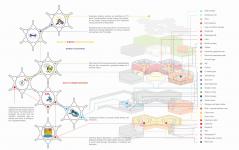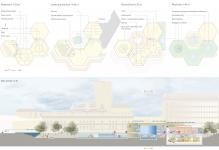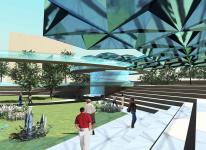The increased global connectivity and current financial instability raise the question of the future of contemporary urban centres. It is therefore interesting
to explore the relashionship between Bradford’s city centre and the Westfield site as a metaphor of such
instability, towards establishing a new manufacturing technique that would render the city economically sustainable and profitable. After analyzing the constraints and opportunities of the existing city center
area, I decided to propose a (re)vival of the Westfield site area to host an edifice, dedicated to the research
and production of graphene along with part of the site given back to the community, where some of the features of the innovative material would be demonstrated through a series of interactive canopies (creatures).
2013
Graphene is extremely profitable in terms of its various applications in electronics, PV cells, conductivity and production of electricity, water filtration, flexibility and strength (200x stronger than steel) and many more.
Its production involves methane as a primary resource, which is one of the greenhouse gases, while its distribution and associated research is executed in ‘‘clean’’ areas and laboratories underground, rendering the Westfield site ideal for the purpose. The proposal aims to reconnect the city centre through 3 bridges positioned at various levels: 0.00m (assuming the existent level of +98.00m at the crossing of Kirgate and Market Street as equivalent
to ground zero for the purpose of the project) and 3.00m ( providing a viewing gallery of the whole area). The building utilizes the sites ‘‘hole’’ and is thus sunk into the ground at -7.00m, to comply with Vibrations Criterion D for clean rooms and laser laboratories.
The area above is allocated to the required full height plenum, thus bringing the main building to level 0.00m. The latter hosts the rest of the laboratories,
break out areas and office spaces, along with a multi-functional public block to the east. The roof creates a bio-diverse area with associated cafeteria and link to the bridges. The scheme also features a small shop at level 0.00m for the distribution of graphene paint.
This innovative application of graphene allows for the development of a multi-layered graphene paint suitable for all surfaces. The coating essentially substitutes PV cells and helps produce electricity in a solar - kinetic energy exchange.










